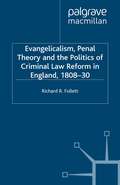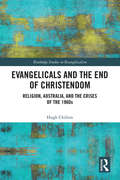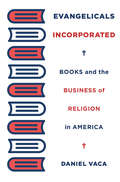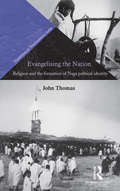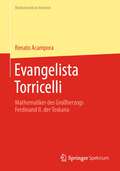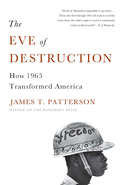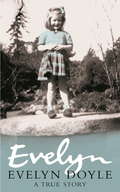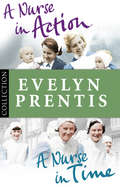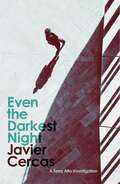- Table View
- List View
The Evangelical Revival
by G.M. DitchfieldThe word-wide impact of evangelicalism has long been recognized as a vital force. Providing both a clear and accessible guide to the recent literature, this introduction examines the revival in the British Isles during the 18th and 19th-century within a broadly international context.By investigating the nature of the revival and emphasizing its link with popular culture, this analysis explores the centrality of religion in this period. Posing questions such a "how far was the revival a threat to order?" And "what was its influence on society?" This work provides an introduction to the topic for all A-level and undergraduate students of 18th and 19th-century British history.
Evangelicalism in Modern Britain: A History from the 1730s to the 1980s
by David W. BebbingtonThis major textbook is a newly researched historical study of Evangelical religion in its British cultural setting from its inception in the time of John Wesley to charismatic renewal today. The Church of England, the Church of Scotland and the variety of Nonconformist denominations and sects in England, Scotland and Wales are discussed, but the book concentrates on the broad patterns of change affecting all the churches. It shows the great impact of the Evangelical movement on nineteenth-century Britain, accounts for its resurgence since the Second World War and argues that developments in the ideas and attitudes of the movement were shaped most by changes in British culture. The contemporary interest in the phenomenon of Fundamentalism, especially in the United States, makes the book especially timely.
Evangelicalism in Modern Britain: A History from the 1730s to the 1980s
by David W. BebbingtonThis major textbook is a newly researched historical study of Evangelical religion in its British cultural setting from its inception in the time of John Wesley to charismatic renewal today. The Church of England, the Church of Scotland and the variety of Nonconformist denominations and sects in England, Scotland and Wales are discussed, but the book concentrates on the broad patterns of change affecting all the churches. It shows the great impact of the Evangelical movement on nineteenth-century Britain, accounts for its resurgence since the Second World War and argues that developments in the ideas and attitudes of the movement were shaped most by changes in British culture. The contemporary interest in the phenomenon of Fundamentalism, especially in the United States, makes the book especially timely.
Evangelicalism, Penal Theory and the Politics of Criminal Law: Reform in England, 1808-30 (Studies in Modern History)
by R. FollettFollowing the abolition of the British slave trade in 1807, a group of politicians began to agitate for reform of England's "bloody code" of criminal statutes. This examines the politics and propaganda of criminal law reform from 1808 to the Whig succession to power in 1830.
The Evangelicals: A Historical, Thematic, and Biographical Guide (Non-ser.)
by Robert Krapohl Charles H. LippyThe different facets of American religious life are more thoroughly understood with an awareness of the Evangelical heritage that intersects the different denominational boundaries. Since Evangelicalism is not confined to one religious denomination or group, it has associations with a number of American religious movements such as Fundamentalism, Pentecostalism, the Charismatic Movement, and Revivalism. This study, modeled after the popular Greenwood Denominations in America series, analyzes the people, institutions, and the religious culture of modern American Evangelicals. Divided into three sections the book presents a history of American Evangelicalism, discusses themes and issues in modern American Evangelicalism, and provides a biographical dictionary of modern American Evangelical leaders.The combination of critical narrative and reference will appeal to religion scholars and American culture scholars alike. Separate bibliographies unique to the history section and to the themes and issues section provide valuable resources for further research. Equally helpful is the bibliographic material that completes each entry in the biographical dictionary section of the book. The three part organization makes this an accessible research tool, clearly organized for easy cross referencing.
Evangelicals and Science in Historical Perspective (Religion in America)
by David N. Livingstone D. G. Hart Mark A. NollIn the eighteenth and nineteenth centuries, evangelicals often took their place among prominent practicing scientists, and their perspectives exerted a considerable impact on the development of modern western science. Over the last century, however, evangelical scientists have become less visible, even as the focus of evangelical engagement has shifted to political and cultural spheres. Evangelicals and Science in Historical Perspective offers the first wide-ranging survey of the history of the encounter between evangelical Protestantism and science. Comprising papers by leading historians of science and religion, this collection shows that the questions of science have been central to the history of evangelicalism in the United States, as well as in Britain and Canada. It will be an invaluable resource for understanding the historical context of contemporary political squabbles, such as the debate over the status of creation science and the teaching of evolution.
Evangelicals and the End of Christendom: Religion, Australia and the Crises of the 1960s (Routledge Studies in Evangelicalism)
by Hugh ChiltonExploring the response of evangelicals to the collapse of ‘Greater Christian Britain’ in Australia in the long 1960s, this book provides a new religious perspective to the end of empire and a fresh national perspective to the end of Christendom. In the turbulent 1960s, two foundations of the Western world rapidly and unexpectedly collapsed. ‘Christendom’, marked by the dominance of discursive Christianity in public culture, and ‘Greater Britain’, the powerful sentimental and strategic union of Britain and its settler societies, disappeared from the collective mental map with startling speed. To illuminate these contemporaneous global shifts, this book takes as a case study the response of Australian evangelical Christian leaders to the cultural and religious crises encountered between 1959 and 1979. Far from being a narrow national study, this book places its case studies in the context of the latest North American and European scholarship on secularisation, imperialism and evangelicalism. Drawing on a wide range of archival sources, it examines critical figures such as Billy Graham, Fred Nile and Hans Mol, as well as issues of empire, counter-cultural movements and racial and national identity. This study will be of particular interest to any scholar of Evangelicalism in the twentieth century. It will also be a useful resource for academics looking into the wider impacts of the decline of Christianity and the British Empire in Western civilisation.
Evangelicals and the End of Christendom: Religion, Australia and the Crises of the 1960s (Routledge Studies in Evangelicalism)
by Hugh ChiltonExploring the response of evangelicals to the collapse of ‘Greater Christian Britain’ in Australia in the long 1960s, this book provides a new religious perspective to the end of empire and a fresh national perspective to the end of Christendom. In the turbulent 1960s, two foundations of the Western world rapidly and unexpectedly collapsed. ‘Christendom’, marked by the dominance of discursive Christianity in public culture, and ‘Greater Britain’, the powerful sentimental and strategic union of Britain and its settler societies, disappeared from the collective mental map with startling speed. To illuminate these contemporaneous global shifts, this book takes as a case study the response of Australian evangelical Christian leaders to the cultural and religious crises encountered between 1959 and 1979. Far from being a narrow national study, this book places its case studies in the context of the latest North American and European scholarship on secularisation, imperialism and evangelicalism. Drawing on a wide range of archival sources, it examines critical figures such as Billy Graham, Fred Nile and Hans Mol, as well as issues of empire, counter-cultural movements and racial and national identity. This study will be of particular interest to any scholar of Evangelicalism in the twentieth century. It will also be a useful resource for academics looking into the wider impacts of the decline of Christianity and the British Empire in Western civilisation.
Evangelicals Incorporated: Books and the Business of Religion in America
by Daniel VacaAmerican evangelicalism is big business. It is not, Daniel Vaca argues, just a type of conservative Protestantism that market forces have commodified. Rather evangelicalism is an expressly commercial practice, in which the faithful participate, learn, and develop religious identities by engaging corporations and commercial products.
Evangelising the Nation: Religion and the Formation of Naga Political Identity (Transition in Northeastern India)
by John ThomasNortheast India has witnessed several nationality movements during the 20th century. The oldest and one of the most formidable has been that of the Nagas — inhabiting the hill tracts between the Brahmaputra river in India and the Chindwin river in Burma (now Myanmar). Rallying behind the slogan, ‘Nagaland for Christ’, this movement has been the site of an ambiguous relation between a particular understanding of Christianity and nation-making. This book, based on meticulous archival research, traces the making of this relation and offers fresh perspectives on the workings of religion in the formation of political and cultural identities among the Nagas. It tracks the transmutations of Protestantism from the United States to the hill tracts of Northeast India, and its impact on the form and content of the nation that was imagined and longed for by the Nagas. The volume also examines the role of missionaries, local church leaders, and colonial and post-colonial states in facilitating this process. Lucidly written and rigorous in its analyses, this book will be of interest to scholars and researchers of South Asian history, religion, political science, sociology and social anthropology, and particularly those concerned with Northeast India.
Evangelising the Nation: Religion and the Formation of Naga Political Identity (Transition in Northeastern India)
by John ThomasNortheast India has witnessed several nationality movements during the 20th century. The oldest and one of the most formidable has been that of the Nagas — inhabiting the hill tracts between the Brahmaputra river in India and the Chindwin river in Burma (now Myanmar). Rallying behind the slogan, ‘Nagaland for Christ’, this movement has been the site of an ambiguous relation between a particular understanding of Christianity and nation-making. This book, based on meticulous archival research, traces the making of this relation and offers fresh perspectives on the workings of religion in the formation of political and cultural identities among the Nagas. It tracks the transmutations of Protestantism from the United States to the hill tracts of Northeast India, and its impact on the form and content of the nation that was imagined and longed for by the Nagas. The volume also examines the role of missionaries, local church leaders, and colonial and post-colonial states in facilitating this process. Lucidly written and rigorous in its analyses, this book will be of interest to scholars and researchers of South Asian history, religion, political science, sociology and social anthropology, and particularly those concerned with Northeast India.
Evangelista Torricelli: Mathematiker des Großherzogs Ferdinand II. der Toskana (Mathematik im Kontext)
by Renato AcamporaDie meisten Nichtmathematiker werden Torricelli durch das nach ihm benannte Ausflussgesetz kennen, wonach die Geschwindigkeit eines aus einem Gefäss austretenden Wasserstrahls proportional zur Quadratwurzel aus der Füllhöhe ist, ebenso wie durch seinen Nachweis des Luftdrucks mithilfe seines Vakuumexperiments. Viel bedeutender aber sind seine Leistungen auf dem Gebiet der Mathematik als virtuoser Vertreter von Cavalieris umstrittener Indivisiblenmethode, wobei er seine Ergebnisse aber stets mit Beweisen nach der allgemein anerkannten „Art der Alten“ absicherte. Auf diese Weise gelang ihm die Quadratur der Parabeln und Hyperbeln höherer Ordnung, der Zykloide, der logarithmischen Spirale (ebenso wie deren Rektifikation) und die Bestimmung der Schwerpunkte zahlreicher ebener und räumlicher Figuren.
Evangelizing the South: A Social History of Church and State in Early America (Religion in America)
by Monica NajarAlthough many refer to the American South as the "Bible Belt", the region was not always characterized by a powerful religious culture. In the seventeenth century and early eighteenth century, religion-in terms both of church membership and personal piety-was virtually absent from southern culture. The late eighteenth century and early nineteenth century, however, witnessed the astonishingly rapid rise of evangelical religion in the Upper South. Within just a few years, evangelicals had spread their beliefs and their fervor, gaining converts and building churches throughout Virginia and North Carolina and into the western regions. But what was it that made evangelicalism so attractive to a region previously uninterested in religion? Monica Najar argues that early evangelicals successfully negotiated the various challenges of the eighteenth-century landscape by creating churches that functioned as civil as well as religious bodies. The evangelical church of the late eighteenth century was the cornerstone of its community, regulating marriages, monitoring prices, arbitrating business, and settling disputes. As the era experienced substantial rifts in the relationship between church and state, the disestablishment of colonial churches paved the way for new formulations of church-state relations. The evangelical churches were well-positioned to provide guidance in uncertain times, and their multiple functions allowed them to reshape many of the central elements of authority in southern society. They assisted in reformulating the lines between the "religious" and "secular" realms, with significant consequences for both religion and the emerging nation-state. Touching on the creation of a distinctive southern culture, the position of women in the private and public arenas, family life in the Old South, the relationship between religion and slavery, and the political culture of the early republic, Najar reveals the history behind a religious heritage that remains a distinguishing mark of American society.
Evariste Galois 1811–1832 (Vita Mathematica #11)
by Laura Toti RigatelliEvariste Galois' short life was lived against the turbulent background of the restoration of the Bourbons to the throne of France, the 1830 revolution in Paris and the accession of Louis-Phillipe. This new and scrupulously researched biography of the founder of modern algebra sheds much light on a life led with great intensity and a death met tragically under dark circumstances. Sorting speculation from documented fact, it offers the fullest and most exacting account ever written of Galois' life and work. It took more than seventy years to fully understand the French mathematician's first mémoire (published in 1846) which formulated the famous "Galois theory" concerning the solvability of algebraic equations by radicals, from which group theory would follow. Obscurities in his other writings - mémoires and numerous fragments of extant papers - persist and his ideas challenge mathematicians to this day. Thus scholars will welcome those chapters devoted specifically to explicating all aspects of Galois' work. A comprehensive bibliography enumerates studies by and also those about the mathematician.
Eve: How The Female Body Drove 200 Million Years of Human Evolution (Longlisted for the Women's Prize for Non-Fiction)
by Cat BohannonA NEW YORK TIMES BESTSELLERLONGLISTED FOR THE WOMEN'S PRIZE FOR NON-FICTION 2024FOYLE'S NON-FICTION BOOK OF THE YEAR 2023LONGLISTED FOR BLACKWELL'S NON-FICTION BOOK OF THE YEAR 2023ONE OF THE GUARDIAN'S BEST IDEAS BOOKS OF 2023ONE OF THE TELEGRAPH'S FIFTY BEST BOOKS OF 2023ONE OF PROSPECT'S BOOKS OF THE YEAR 2023ONE OF DUA LIPA'S SERVICE95 RECOMMENDATIONS FOR '5 INSPIRING READS TO KICK START THE NEW YEAR''Funny and very important' Chris van Tulleken, bestseling author of Ultra-Processed People'Educates and emboldens' Bonnie Garmus, bestselling author of Lessons in Chemistry'Should revolutionise our understanding of human life' George Monbiot, bestselling author of Regenesis'A vast and revolutionary history of female evolution' Sunday TimesHow did wet nurses drive civilization? Are women always the weaker sex? Is sexism useful for evolution? And are our bodies at war with our babies?In Eve, Cat Bohannon answers questions scientists should have been addressing for decades. With boundless curiosity and sharp wit, she covers the past 200 million years to explain the specific science behind the development of the female sex. Eve is not only a sweeping revision of human history, it's an urgent and necessary corrective for a world that has focused primarily on the male body for far too long. Bohannon's findings, including everything from the way C-sections in the industrialized world are rearranging women's pelvic shape to the surprising similarities between pus and breast milk, will completely change what you think you know about evolution and why Homo sapiens have become such a successful and dominant species, from tool use to city building to the development of language.
The Eve of Destruction: How 1965 Transformed America
by James T. Pattersone much more staid recordings of contemporary acts like Frank Sinatra, Julie Andrews, and the Supremes, reflecting an alienation from mainstream American culture shared by an increasing number of young Americans. In The First Year of the Sixties, James T. Patterson traces the transformative events of this critical year, showing how 1965 saw an idealistic and upbeat nation derailed by developments both at home and abroad. An entire generation of Americans—as well as the country&’s politics, culture, race relations, and foreign policies—would never be the same.
The Eve of Spain: Myths of Origins in the History of Christian, Muslim, and Jewish Conflict
by Patricia E. GrieveThe Eve of Spain demonstrates how the telling and retelling of one of Spain’s founding myths played a central role in the formation of that country’s national identity. King Roderigo, the last Visigoth king of Spain, rapes (or possibly seduces) La Cava, the daughter of his friend and counselor, Count Julian. In revenge, the count travels to North Africa and conspires with its Berber rulers to send an invading army into Spain. So begins the Muslim conquest and the end of Visigothic rule. A few years later, in Northern Spain, Pelayo initiates a Christian resistance and starts a new line of kings to which the present-day Spanish monarchy traces its roots.Patricia E. Grieve follows the evolution of this story from the Middle Ages into the modern era, as shifts in religious tolerance and cultural acceptance influenced its retelling. She explains how increasing anti-Semitism came to be woven into the tale during the Christian conquest of the peninsula—in the form of traitorous Jewish conspirators. In the sixteenth century, the tale was linked to the looming threat of the Ottoman Turks. The story continued to resonate through the Enlightenment and into modern historiography, revealing the complex interactions of racial and religious conflict and evolving ideas of women’s sexuality.In following the story of La Cava, Rodrigo, and Pelayo, Grieve explains how foundational myths and popular legends articulate struggles for national identity. She explores how myths are developed around few historical facts, how they come to be written into history, and how they are exploited politically, as in the expulsion of the Jews from Spain in 1492 followed by that of the Moriscos in 1609. Finally, Grieve focuses on the misogynistic elements of the story and asks why the fall of Spain is figured as a cautionary tale about a woman’s sexuality.
The Eve of Spain: Myths of Origins in the History of Christian, Muslim, and Jewish Conflict
by Patricia E. GrieveThe Eve of Spain demonstrates how the telling and retelling of one of Spain’s founding myths played a central role in the formation of that country’s national identity. King Roderigo, the last Visigoth king of Spain, rapes (or possibly seduces) La Cava, the daughter of his friend and counselor, Count Julian. In revenge, the count travels to North Africa and conspires with its Berber rulers to send an invading army into Spain. So begins the Muslim conquest and the end of Visigothic rule. A few years later, in Northern Spain, Pelayo initiates a Christian resistance and starts a new line of kings to which the present-day Spanish monarchy traces its roots.Patricia E. Grieve follows the evolution of this story from the Middle Ages into the modern era, as shifts in religious tolerance and cultural acceptance influenced its retelling. She explains how increasing anti-Semitism came to be woven into the tale during the Christian conquest of the peninsula—in the form of traitorous Jewish conspirators. In the sixteenth century, the tale was linked to the looming threat of the Ottoman Turks. The story continued to resonate through the Enlightenment and into modern historiography, revealing the complex interactions of racial and religious conflict and evolving ideas of women’s sexuality.In following the story of La Cava, Rodrigo, and Pelayo, Grieve explains how foundational myths and popular legends articulate struggles for national identity. She explores how myths are developed around few historical facts, how they come to be written into history, and how they are exploited politically, as in the expulsion of the Jews from Spain in 1492 followed by that of the Moriscos in 1609. Finally, Grieve focuses on the misogynistic elements of the story and asks why the fall of Spain is figured as a cautionary tale about a woman’s sexuality.
Eve Tempted: Writing and Sexuality in Hawthorne's Fiction (Routledge Library Editions: The Nineteenth-Century Novel)
by Allan Gardner Lloyd SmithFirst published in 1984, this book offers a unique interpretation of Hawthorne’s work, making use of perspectives opened up by Derrida in his work on Rousseau. It offers a psycho-biography of the author as discoverable in the texts and avoids a simplistic Freudian analysis. In doing so, it illuminates the work and re-opens Hawthorne’s texts to creative discussion. This book will be of interest to those studying 19th century literature.
Eve Tempted: Writing and Sexuality in Hawthorne's Fiction (Routledge Library Editions: The Nineteenth-Century Novel)
by Allan Gardner Lloyd SmithFirst published in 1984, this book offers a unique interpretation of Hawthorne’s work, making use of perspectives opened up by Derrida in his work on Rousseau. It offers a psycho-biography of the author as discoverable in the texts and avoids a simplistic Freudian analysis. In doing so, it illuminates the work and re-opens Hawthorne’s texts to creative discussion. This book will be of interest to those studying 19th century literature.
Evelyn: A True Story
by Evelyn DoyleTold through the eyes of his daughter Evelyn, this is the true story of a father's fight to reclaim his children from the Irish government in the 1950s, now a major film.Desmond Doyle, 29, a painter and decorator, is married with six children and living in the infamous Fatima Mansions in Dublin in 1953. One day he comes home to find his wife has left him. He decides to go to England to find work and is advised to put his children into the state Industrial Schools system for a short time until he returns. When he returns he is told to his horror that the children have been consigned to the state until they are 16. This is the story of how Desmond Doyle fought the Irish legal system to change the law and win back his family.
Evelyn Prentis Bundle: A Nurse in Time/A Nurse in Action
by Evelyn PrentisDesperate circumstances were something Evelyn Prentis had to get very used to when she began her life as a nurse. It was in 1934 that Evelyn left home for the first time to enrol as a trainee at a busy Nottingham hospital in the hope of £25 a year. A Nurse in Time is Evelyn's affectionate and funny account of those days of dedication and hardship, when never-ending nightshifts, strict Sisters and permanent hunger ruled life, and joy was to be found in a late-night pass and a packet of Woodbines.The second memoir in this collection is A Nurse in Action. Surprising Matron as well as herself, Evelyn Prentis managed to pass her Finals and become a staff-nurse. Encouraged, she took the brave leap of moving from Nottingham to London - brave not least because war was about to break. Not only did the nurses have to cope with stray bombs and influxes of patients from as far away Dunkirk, but there were also RAF men stationed nearby - which caused considerable entertainment and disappointment, and a good number of marriages ...But despite all the disruption to the hospital routine, Evelyn's warm and compelling account of a nurse in action, shows a nurse's life would always revolve around the comforting discomfort of porridge and rissoles, bandages and bedpans.
Even More Merseyside Tales!: Curious and Amazing True Tales from History
by Ken PyeIn Ken Pye's third collection of strange and often bizarre tales from Merseyside’s History, prepare to be amazed and entertained, once again.Where on Merseyside was the nonsense rhyme, ‘The Owl and The Pussycat’ written? How did the 'Cast Iron Shore’ or the Cazzie get its name? Is there a lost street running beneath Lime Street?Learn about 'Roast Beef’ the Crosby Hermit, the prehistoric footprints on Formby Shore, and the particularly intimate wax models of diseased body parts found in the Paradise Street Museum of Anatomy. There are over fifty such true stories and secret wonders in this amazingly eclectic book, but consider yourself warned – once you begin reading these tales you might find it hard to stop!
Even the Darkest Night: A Terra Alta Investigation
by Javier CercasA Melchor Marín novel. Winner of Spain's biggest literary prize - the Premio PlanetaWhen Melchor goes to investigate the horrific double-murder of a rich printer and his wife in rural Cataluña nothing quite adds up. The young cop from the big city, hero of a foiled terrorist attack, has been sent to Terra Alta till things quieten down. Observant, streetwise and circumspect, Melchor is also an outsider.The son of a Barcelona prostitute who never knew his father, Melchor rapidly fell into trouble and was jailed at 19, convicted of driving for a Colombian drug cartel. While he was behind bars, he read Hugo's Les Misérables, and then his mother was murdered. Admiring of both Jean Valjean and Javert - but mostly the relentless Javert - he decided to become a policeman.Now he is out for revenge, but he can wait, and meanwhile he has discovered happiness with his wife, the local librarian, and their daughter, who is, of course, called Cossette.Slowly at first, and then more rapidly once ordered to abandon the case, he tracks the clues that will reveal the larger truth behind what appears at first to be a cold-blooded, professional killing.Translated from the Spanish by Anne McLean


